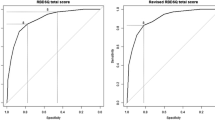Abstract
A screening tool can greatly facilitate the identification of individuals with rapid eye movement (REM) sleep behaviour disorder (RBD). Currently, the REM sleep behaviour disorder screening questionnaire (RBDSQ) is widely used, but its diagnostic accuracy has varied across previous studies. The aim of the present study was to systematically assess the diagnostic performance of the RBDSQ. We comprehensively searched for studies that evaluated the diagnostic performance of the RBDSQ. A bivariate mixed-effects model was used to summarize the diagnostic accuracy of the RBDSQ. Subgroup analyses were performed according to the study design and the different populations included in the studies. Ten studies were included. Using a cutoff value of 5, the pooled sensitivity, specificity, positive likelihood ratio, negative likelihood ratio, and diagnostic odds ratio were 0.91 (95% CI 0.85–0.95), 0.77 (95% CI 0.66–0.85), 4.00 (95% CI 2.60–6.10), 0.12 (95% CI 0.07–0.19), and 34 (95% CI 16–71), respectively. A subgroup analysis revealed that the RBDSQ had excellent diagnostic accuracy for RBD screening in the general population. However, its performance in specific patient populations, especially patients with Parkinson’s disease, was less satisfactory. In conclusion, the RBDSQ is an effective diagnostic screening tool for RBD in the general population, but its performance in subjects with specific neurological disorders requires more comprehensive assessments.




Similar content being viewed by others
References
Olson EJ, Boeve BF, Silber MH (2000) Rapid eye movement sleep behaviour disorder: demographic, clinical and laboratory findings in 93 cases. Brain 123(Pt 2):331–339
Manni R, Ratti PL, Terzaghi M (2011) Secondary “incidental” REM sleep behavior disorder: do we ever think of it? Sleep Med 12(Suppl 2):S50–S53
Kang SH, Yoon IY, Lee SD, Han JW, Kim TH, Kim KW (2013) REM sleep behavior disorder in the Korean elderly population: prevalence and clinical characteristics. Sleep 36(8):1147–1152
White C, Hill EA, Morrison I, Riha RL (2012) Diagnostic delay in REM sleep behavior disorder (RBD). J Clin Sleep Med 8(2):133–136
Postuma RB, Gagnon JF, Vendette M, Fantini ML, Massicotte-Marquez J, Montplaisir J (2009) Quantifying the risk of neurodegenerative disease in idiopathic REM sleep behavior disorder. Neurology 72(15):1296–1300
Frauscher B, Gschliesser V, Brandauer E, Marti I, Furtner MT, Ulmer H, Poewe W, Hogl B (2010) REM sleep behavior disorder in 703 sleep-disorder patients: the importance of eliciting a comprehensive sleep history. Sleep Med 11(2):167–171
Iranzo A, Santamaria J, Tolosa E (2016) Idiopathic rapid eye movement sleep behaviour disorder: diagnosis, management, and the need for neuroprotective interventions. Lancet Neurol 15(4):405–419
Lee SA, Paek JH, Han SH, Ryu HU (2015) The utility of a Korean version of the REM sleep behavior disorder screening questionnaire in patients with obstructive sleep apnea. J Neurol Sci 358(1–2):328–332
Miyamoto T, Miyamoto M, Iwanami M, Kobayashi M, Nakamura M, Inoue Y, Ando C, Hirata K (2009) The REM sleep behavior disorder screening questionnaire: validation study of a Japanese version. Sleep Med 10(10):1151–1154
Chahine LM, Daley J, Horn S, Colcher A, Hurtig H, Cantor C, Dahodwala N (2013) Questionnaire-based diagnosis of REM sleep behavior disorder in Parkinson’s disease. Mov Disord 28(8):1146–1149
Stiasny-Kolster K, Sixel-Döring F, Trenkwalder C, Heinzel-Gutenbrunner M, Seppi K, Poewe W, Högl B, Frauscher B (2015) Diagnostic value of the REM sleep behavior disorder screening questionnaire in Parkinson’s disease. Sleep Med 16(1):186–189
Whiting PF, Rutjes AW, Westwood ME, Mallett S, Deeks JJ, Reitsma JB, Leeflang MM, Sterne JA, Bossuyt PM; Group Q (2011) QUADAS-2: a revised tool for the quality assessment of diagnostic accuracy studies. Ann Intern Med 155 (8):529–536
Marelli S, Rancoita PM, Giarrusso F, Galbiati A, Zucconi M, Oldani A, Di Serio C, Ferini-Strambi L (2016) National validation and proposed revision of REM sleep behavior disorder screening questionnaire (RBDSQ). J Neurol 263(12):2470–2475
Nomura T, Inoue Y, Kagimura T, Uemura Y, Nakashima K (2011) Utility of the REM sleep behavior disorder screening questionnaire (RBDSQ) in Parkinson’s disease patients. Sleep Med 12(7):711–713
Stiasny-Kolster K, Mayer G, Schäfer S, Möller JC, Heinzel-Gutenbrunner M, Oertel WH (2007) The REM sleep behavior disorder screening questionnaire—a new diagnostic instrument. Mov Disord 22(16):2386–2393
Tari Comert I, Pelin Z, Aricak T, Yapan S (2016) Validation of the Turkish version of the rapid eye movement sleep behavior disorder questionnaire. Behav Neurol 2016:8341651
Wang Y, Wang ZW, Yang YC, Wu HJ, Zhao HY, Zhao ZX (2015) Validation of the rapid eye movement sleep behavior disorder screening questionnaire in China. J Clin Neurosci 22(9):1420–1424
Zha S, Ma J, Chen S (2016) Evaluation of screening questionnaires for rapid eye movement sleep behavior disorder. J Diagn Concepts Pract 15(3):258–262
Lim DC, Pack AI (2017) Obstructive sleep apnea: update and future. Annu Rev Med 68:99–112
Ohayon MM (2002) Epidemiology of insomnia: what we know and what we still need to learn. Sleep Med Rev 6(2):97–111
Chahine LM, Amara AW, Videnovic A (2016) A systematic review of the literature on disorders of sleep and wakefulness in Parkinson’s disease from 2005 to 2015. Sleep Med Rev. doi:10.1016/j.smrv.2016.08.001
Ylikoski A, Martikainen K, Sieminski M, Partinen M (2015) Parkinson’s disease and insomnia. Neurol Sci 36(11):2003–2010
Yong MH, Fook-Chong S, Pavanni R, Lim LL, Tan EK (2011) Case control polysomnographic studies of sleep disorders in Parkinson’s disease. PLoS One 6(7):e22511
Acknowledgements
This research was supported by two grants from Beijing Hospital, National Center of Gerontology, China (Grant Nos. bj-2015-027 and 211-2016009).
Author information
Authors and Affiliations
Corresponding authors
Ethics declarations
Conflict of interest
The authors declare no conflicts of interest.
Rights and permissions
About this article
Cite this article
Li, K., Li, SH., Su, W. et al. Diagnostic accuracy of REM sleep behaviour disorder screening questionnaire: a meta-analysis. Neurol Sci 38, 1039–1046 (2017). https://doi.org/10.1007/s10072-017-2886-9
Received:
Accepted:
Published:
Issue Date:
DOI: https://doi.org/10.1007/s10072-017-2886-9




